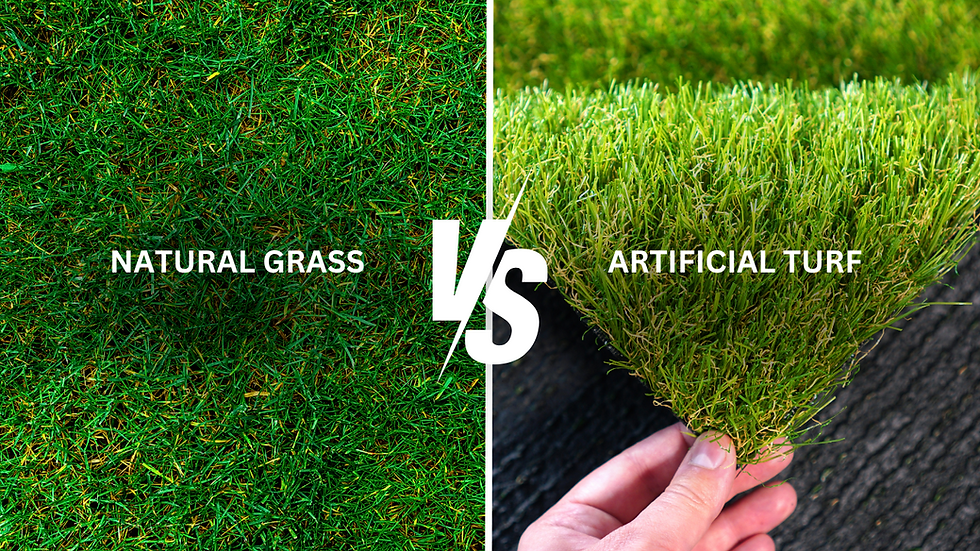Natural Grass vs Artificial Turf: Pros and Cons for Homeowners
- RIP Landscapes

- Aug 22
- 3 min read
When it comes to creating a beautiful, functional yard, homeowners often find themselves weighing one big question: Should I choose natural grass or artificial turf? Both options can dramatically change the look and feel of your outdoor space, but they each come with advantages and trade-offs that are worth considering.
If you’re a homeowner in Auburn or Opelika, Alabama, this decision is even more important. Our hot summers, variable rainfall, and family-oriented lifestyles make lawn care a priority. Let’s break down the pros and cons of natural grass vs artificial turf so you can choose the right fit for your home.

Natural Grass: The Classic Choice
For decades, natural grass has been the go-to for homeowners. It’s hard to beat the soft, cooling feel of a lush green lawn under your feet on a summer evening.
Pros of Natural Grass
Cooling effect: Natural grass reduces heat around your home, which is especially valuable during Auburn’s sweltering summers.
Supports local ecosystems: Grass provides a home for pollinators and helps maintain healthy soil.
Aesthetic appeal: Many homeowners love the natural scent, color, and seasonal changes of a living lawn.
Lower upfront cost: Installing sod or seeding a lawn usually costs less initially compared to turf.
Cons of Natural Grass
Maintenance demands: Mowing, watering, fertilizing, and weed control can become time-consuming and expensive.
Vulnerability: Natural grass can develop brown patches, weeds, and pest problems.
Water use: Keeping a lawn green during dry Alabama months requires consistent irrigation.
Seasonal look: Grass may not stay vibrant year-round, particularly in winter or drought conditions.
Artificial Turf: The Low-Maintenance Alternative
Artificial turf has become increasingly popular for homeowners who want a green lawn without the hassle of constant upkeep.
Pros of Artificial Turf
Year-round greenery: Turf stays green, uniform, and manicured regardless of the season.
Minimal upkeep: No watering, mowing, or fertilizing required.
Durability: High-quality turf can last 10–20 years with proper care.
Great for high-traffic areas: Turf handles kids, pets, and backyard sports without turning into mud.
Cons of Artificial Turf
Upfront cost: Installation is significantly more expensive compared to seeding or sod.
Heat retention: Turf can get hot under direct sun, making it less comfortable in Alabama’s peak summer heat.
Environmental trade-offs: Turf doesn’t support local ecosystems and can disrupt soil health.
Cleaning needs: Pet owners may need to wash turf regularly to prevent odors.
Replacement down the line: While long-lasting, turf eventually needs replacing, which can add costs.
Cost Comparison: Grass vs Turf
When comparing natural grass and artificial turf, cost plays a big role.
Natural Grass: Lower installation costs, but higher ongoing expenses for water, fertilizer, and maintenance equipment.
Artificial Turf: High upfront investment, but very low maintenance costs long-term.
In Auburn and Opelika’s climate, homeowners who prefer a low-maintenance lifestyle often lean toward turf, while those who enjoy gardening or want a natural yard stick with grass.
Environmental Considerations
Water use: Turf conserves water, while grass requires regular irrigation.
Soil and ecosystem health: Natural grass supports soil biodiversity and pollinators; turf does not.
End-of-life impact: Disposing of old turf can be challenging, while grass naturally regenerates.
Which Option Is Right for You?
Choosing between natural grass and artificial turf comes down to lifestyle and priorities:
Choose natural grass if… you love gardening, prefer a living ecosystem, and don’t mind regular upkeep.
Choose artificial turf if… you want a perfect-looking lawn year-round, need durability for pets and kids, and are okay with the upfront investment.
For Auburn and Opelika homeowners, climate should also factor in. Grass requires ongoing irrigation during hot summers, while turf may heat up too much in direct sun. The right choice depends on how you’ll use your yard and how much time you want to spend maintaining it.
Conclusion
Both natural grass and artificial turf offer clear benefits, but they serve very different homeowner needs. Grass is classic, eco-friendly, and affordable upfront, while turf delivers unmatched convenience and year-round curb appeal.
At RIP Landscapes, we help Auburn and Opelika homeowners make the best choice for their yard. Whether you’re considering sod installation, reseeding, or exploring turf options, our team can guide you through every step and ensure your landscape matches your vision.
👉 Ready to transform your lawn? Contact RIP Landscapes today to schedule a consultation and find the perfect landscaping solution for your home.
